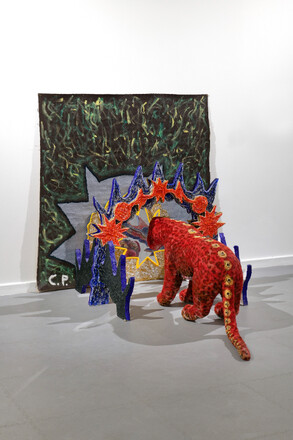YOUNÈS BEN SLIMANE, LATIFA ECHAKHCH, VALÉRIE JOUVE, JEAN-CHARLES MASSERA, CHARLEMAGNE PALESTINE, UTOPIA STATION
As part of the 13th edition of the "Curatorial Practices" UE led by the teams of IAC Villeurbanne and ENS de Lyon (Stéphanie Fragnon and David Gauthier).
Extraneus: That Which is External, Still Unknown
From this same Latin etymology—\eks.ˈtɾaː.neu̯s\ in phonetics—come two adjectives, "strange" and "foreign," with significantly different meanings. While the former conveys a reaction of surprise or curiosity, the latter is more denotative, describing that which does not belong to a referenced group. The linguistic evolution that led to this bifurcation is not merely anecdotal. More than simple words, these adjectives have become structuring concepts that shape our relationship to the world, as evidenced by their instrumentalization in public debate.
Several of the exhibited artists play with language to demonstrate its biases and dead ends. By working on the relationship between text and image, they reveal the gap between words and reality. Language unfolds as a tool of perception, a structure of thought that deserves to be questioned in its own right.
Extraneus: Everything That Surrounds Us, Upon Which Our Gaze Falls
What perception of strangeness? How to view otherness? These are the questions around which the artists chosen for the exhibition \eks.ˈtɾaː.neu̯s\ gather. From plush toys to individuals encountered on the street and quickly forgotten, our entire environment is, in reality, foreign to us. However, there exists a continuum of reactions to strangeness, from a curious gaze that seeks to discover the strange, to an indifferent gaze that remains unmoved by the foreign, or even rejects it.
Addressing questions of encounters and becoming, the works offer a variety of perspectives on strangeness. They may surprise, provoke, denounce the hypocrisy of a reaction, exhort empathy, or question the human condition. Each work explores different ways of approaching strangeness, inviting visitors to question their own perspectives.
Extraneus: That Which Questions the Role of the Individual
Encountering strangeness also means becoming aware of one's own biases, recognizing that unconscious prejudices have been ingrained in us. By diverting the mediums of mass communication, the artists disrupt our stances: how is an individual's gaze instrumentalized by hegemonic discourses? And how can one emancipate from it? The exhibition \eks.ˈtɾaː.neu̯s\ offers a space for questioning and uncertainties in various sensitive aspects of strangeness.
Extraneus: That Which is External, Still Unknown
From this same Latin etymology—\eks.ˈtɾaː.neu̯s\ in phonetics—come two adjectives, "strange" and "foreign," with significantly different meanings. While the former conveys a reaction of surprise or curiosity, the latter is more denotative, describing that which does not belong to a referenced group. The linguistic evolution that led to this bifurcation is not merely anecdotal. More than simple words, these adjectives have become structuring concepts that shape our relationship to the world, as evidenced by their instrumentalization in public debate.
Several of the exhibited artists play with language to demonstrate its biases and dead ends. By working on the relationship between text and image, they reveal the gap between words and reality. Language unfolds as a tool of perception, a structure of thought that deserves to be questioned in its own right.
Extraneus: Everything That Surrounds Us, Upon Which Our Gaze Falls
What perception of strangeness? How to view otherness? These are the questions around which the artists chosen for the exhibition \eks.ˈtɾaː.neu̯s\ gather. From plush toys to individuals encountered on the street and quickly forgotten, our entire environment is, in reality, foreign to us. However, there exists a continuum of reactions to strangeness, from a curious gaze that seeks to discover the strange, to an indifferent gaze that remains unmoved by the foreign, or even rejects it.
Addressing questions of encounters and becoming, the works offer a variety of perspectives on strangeness. They may surprise, provoke, denounce the hypocrisy of a reaction, exhort empathy, or question the human condition. Each work explores different ways of approaching strangeness, inviting visitors to question their own perspectives.
Extraneus: That Which Questions the Role of the Individual
Encountering strangeness also means becoming aware of one's own biases, recognizing that unconscious prejudices have been ingrained in us. By diverting the mediums of mass communication, the artists disrupt our stances: how is an individual's gaze instrumentalized by hegemonic discourses? And how can one emancipate from it? The exhibition \eks.ˈtɾaː.neu̯s\ offers a space for questioning and uncertainties in various sensitive aspects of strangeness.


